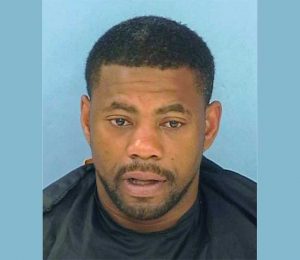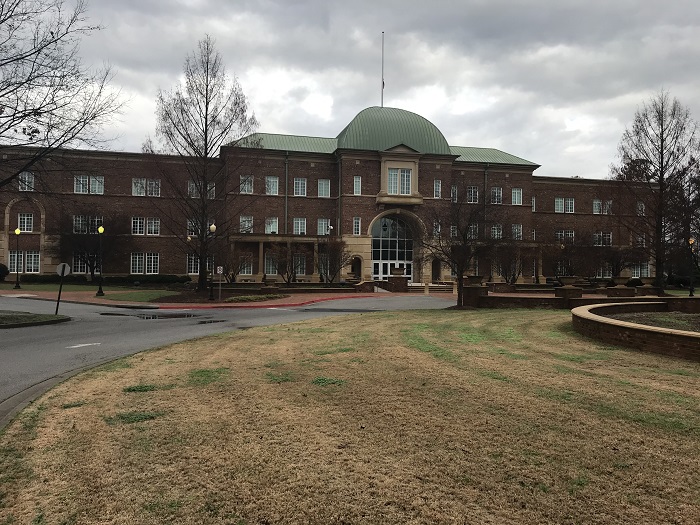
In the Fayette County trial of Fayetteville resident Shanard D. Rease, 39, charged with murdering his 63-year-old neighbor, Mimi Perry, at her Fayetteville home last spring, the prosecutor said the woman was “viciously and violently attacked by her next-door neighbor (Rease). She made a decision, or instinct, when attacked. She fought back in an effort to save her life.”
Assistant District Attorney Dan Hiatt in the prosecution’s opening statement said the evidence will show that DNA found on Perry’s body, specifically her fingernails, came from Rease. Perry’s body was found by a neighbor.
The murder trial of Fayetteville resident Shanard D. Rease began Jan. 13 in Fayette County Superior Court. Rease is facing charges of felony murder, malice murder and aggravated assault in the May 24, 2019 death of well-known resident Mimi Perry at her Fayetteville home.
The case heard before Superior Court Judge Christopher Edwards was presented by Defense attorney Chris Ramig and Assistant D.A. Hiatt.
Affidavits relating to the charges against 39-year-old Rease in connection with the murder of the 63-year-old Perry said Rease “did cause her death by strangulation and causing a fracture of her hyoid bone (in the midline of the neck) and blunt force trauma to the head.”
Perry resided at a condo on Bay Branch Boulevard off Ga. Highway 54 East. Rease lives next door

.
Perry was found in the backyard/patio area near the condo in which she resided. Her naked body was found laying on the ground on her back, with a nightgown/dress lying next to the nearby fence.
The first day of the trial was taken up with jury selection, with the second day beginning with opening statements by the prosecution and defense.
Hiatt said when interviewing Rease, investigators noticed injuries to Rease’s arms and back. The crescent-shaped injuries were believed to be fingernail marks that were left by Mimi Perry, Hiatt added.
“The DNA matched,” Hiatt said.
Ramig in his opening statement said that while “There is no doubt this was a horrible crime, that doesn’t mean my client is the murderer.”
Acknowledging that Rease and Perry were next door neighbors, Ramig said Rease’s mother (with whom he lives) later in the trial will testify to his innocence because, “Due to the configuration of the (multi-story) condo, he was on the upper level, there is no way he could get past his mom to get to Mimi.”
Ramig called into question the DNA report, saying it represented “almost all the eggs in the DA’s basket,” adding that there are problems with the DNA that will be addressed later in the trial.
Regarding “touch DNA” which can be left on objects merely by touching them, Ramig said Rease told investigators he had helped Perry move a flower pot. Ramig said he deposited his DNA on the flower pot that Perry could have later touched.
The first witness called was Perry’s roommate, an 18-year resident of the condo. She confirmed that Perry lived in the ground floor portion of the three-level condo that opens up to a patio and the backyard area.
The roommate said the two had returned home around 3 p.m. on May 24, with Perry planning to go to the Whitewater High School graduation at 7 p.m. She said Perry went to her quarters on the first level. Having later gone downstairs, the roommate found the lights and TV on and the door closed, finding that Perry was not in the residence and concluding that she left. It was after that when a neighbor came to the door saying there was a body behind the building, she said.
Also testifying were Fayetteville Police officers Lee Huddleston and Eric Dorsey.
Huddleston responded to the call of a deceased person and had his body camera activated.
Though it showed no close-ups, the video showed naked Perry’s body lying near the corner of the building near her condo and patio, with her legs essentially straight and her arms by her side.
A few feet away next to the fence was a piece of what was described as a purple-colored clothing, apparently a nightgown, shirt or dress.
There was also a clump of hair that appeared to be that of Perry laying in the area of the body, Huddleston said.
Referencing videos from body cameras worn by Huddleston and Dorsey while speaking with neighbors, including Rease, Ramig was told that Rease, wearing a short-sleeve shirt, made no effort to conceal his arms from officers.
The third day of the trail began with a Ga. Bureau of Investigation analyst testifying on the DNA profile reports that were generated. DNA swabs were taken from Perry, Rease and four other people, including her roommate.
The report noted that a DNA examination of the fingernails of Perry’s right hand showed significant DNA evidence under her fingernails. The DNA, in approximately equal volumes, belonged to Perry and Rease.
The frequency of the foreign profile (Rease’s DNA) would be approximately 1 in 1 septillion (1 followed by 24 0s), the analyst said, adding that that compares to the global population of approximately 7.5 billion.
The fingernails of Perry’s left hand had substantially less DNA evidence under them, with a larger amount belonging to Perry.
Ramig on cross examination asked if Rease’s DNA could have been on Perry’s fingernails as a result of “touch DNA” (also referred to as contact DNA), by Rease having touched something later touched by Perry. His point was that Rease said he had recently helped Perry move a large flower pot inside the home that could have put Rease’s DNA in a position to be picked up by Perry.
The analyst noted that it is possible to transfer DNA in that manner, adding such a transfer is more feasible when certain conditions are met. Examples of such conditions include sweaty hands or handling rough surfaces rather than smooth ones.
A significant amount of time was spent with both attorney’s posing questions, and receiving responses, concerning the intricacies pertaining to DNA transfer.
Hiatt asked the analyst if the volume of DNA found under the fingernails of Perry’s right hand would be expected after handling items or scratching her nails across a rough surface. The analyst answered, “No.”
Responding to a question posed by a member of the jury and relating to the significant amount of DNA found on the fingernails of Perry’s right hand, the analyst said he had performed hundreds of DNA screenings, adding that it is “an unusual result to have that much DNA under fingernails.”
Later in the day, the jury heard testimony from Fayetteville police investigator Sgt. Shawn Albea, who led the investigation and conducted the interview with Rease.
Rease during his initial interview (which was played for the jury), and prior to be named as a suspect, said he did not know anything about Perry being murdered. Rease said he would see her sometimes when he went out back to smoke, adding that the last time he saw her was earlier during the week she was killed.
Rease said approximately two days before her death he had helped her move the large flower pot, or vase, from the patio into the house where he sat it on the floor.
At one point during the interview, Albea said he observed marks and scratches in a crescent shape on Rease’s arm and forearm and asked if he could photograph those areas, with Albea in his testimony saying the marks looked relatively fresh. Rease agreed to the photographs.
Rease during the interview provided a timeline of his activities on the day Perry was murdered. He said he arrived home from work during the morning hours and later walked to buy cigarettes at a gas station on nearby Ga. Highway 54.
Fayetteville Officer David Cagle, who was also present at the Rease interview, testified later in the day that he had reviewed the multiple cameras at the store, and that he did not see Rease in the video.
The trial will continue on Jan. 16, with additional witnesses expected to be called.













Leave a Comment
You must be logged in to post a comment.